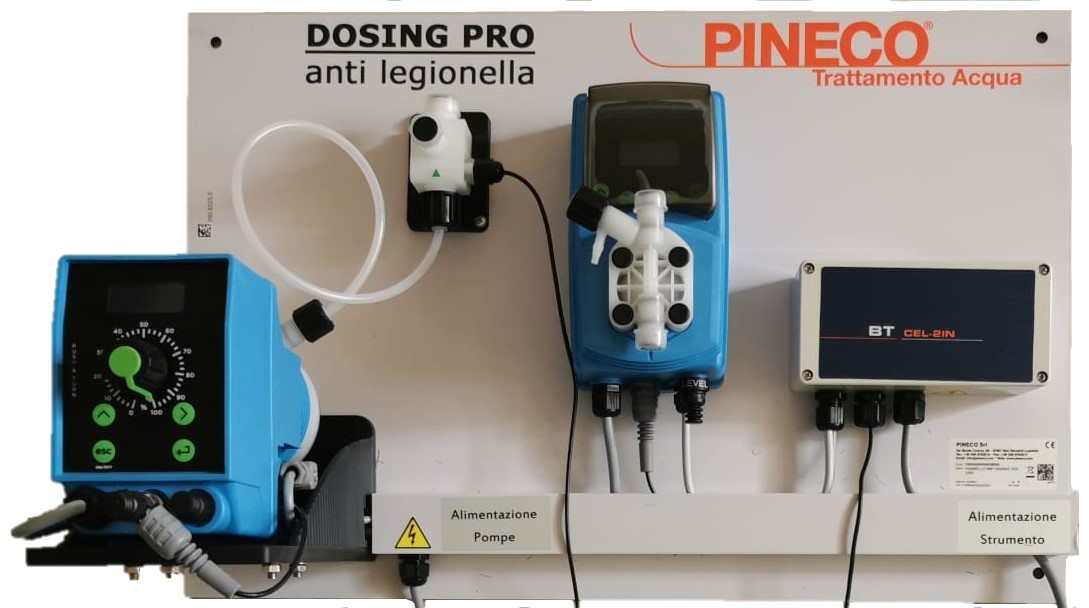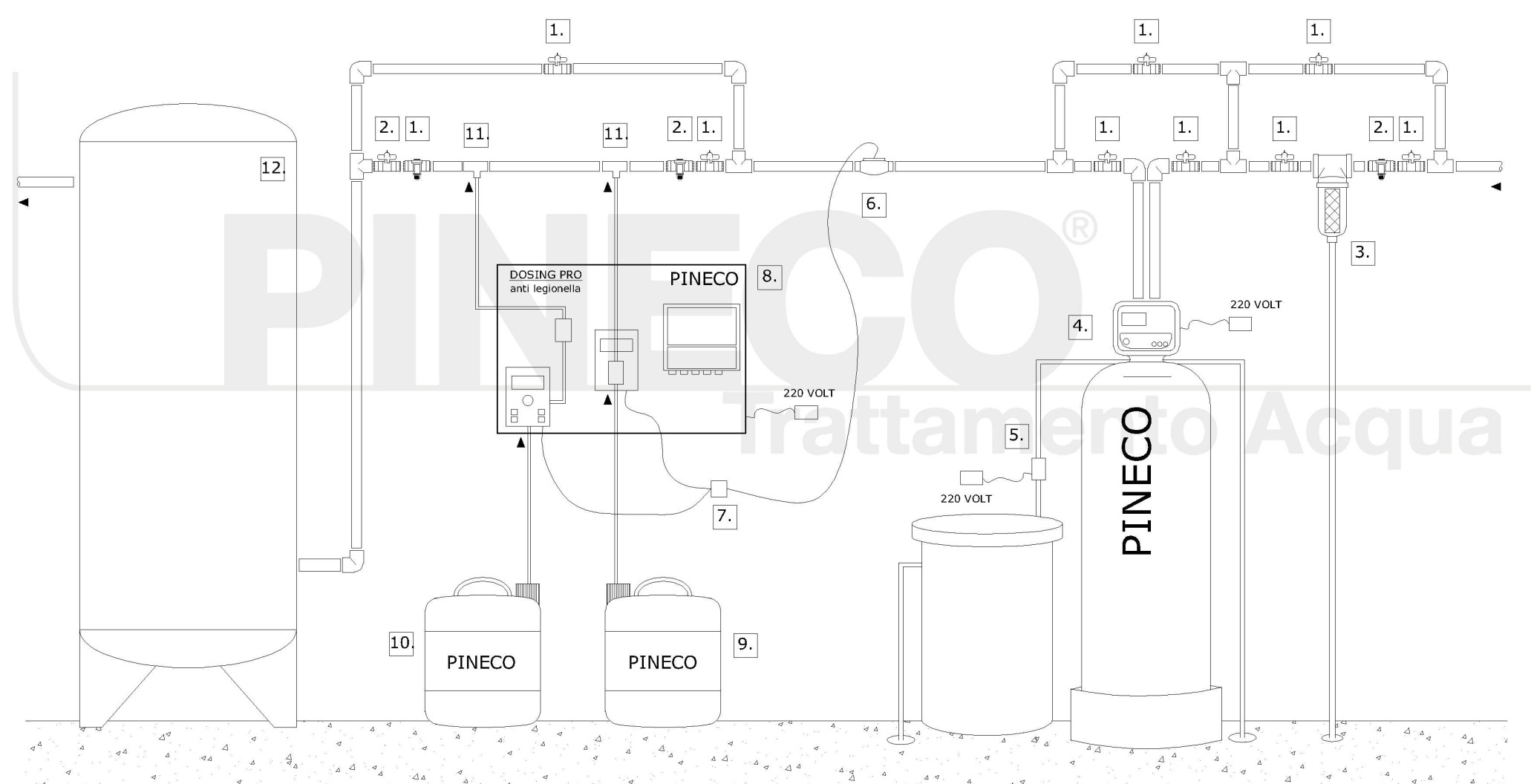
Legionella prevention
WHAT IT IS LEGIONELLA?
The Legionellaires’ disease is a lung infection first discovered in 1976 at the American Legion Convention in Philadelphia when it affected 221 veterans and caused 34 deaths. The symptoms of this disease are the same of other atypical or bacterial pneumonias and can be detected by the way it spreads in the body. The Legionellaires’ disease is letal in the 5-15% cases.
The legionella diseases may be contracted by inhaling contaminated aerosolized water, conditions that may occur by simply taking a shower.
Water tanks, scale deposits, shower outlets, taps, and hot water accumulators, biofilm deposits, plastic and rubber parts are at a high risk of being a source of legionella in the water line. Legionella, infact, colonizes the surface of scale and organic sediments and it is showed to increase its proliferation in a temperature between 20÷45°C.
.png)
LEGIONELLA PREVENTION
There is no vaccine currently available for Legionnaires’ disease, it can only be can only be prevented.
According to the EWGLI, the preventive measures to Legionella are:
- Correct design of the water line: to avoid areas of low flow and stagnation
- Scale removal and prevention: since the deposition of scale on surfaces in the distribution network increases the surface area for bacterial colonization, it is important to prevent the formation of scale (with water softeners or polyphosphate) or to remove any existing scale deposits.
- Physical or chemical water treatment: to disinfect the water, eliminate the bacterial load and prevent the formation of legionella.
The table below describes the alternative methods of preventing legionella in water plants and summarize the advantages and the disadvantages of each system.
|
TREATMENT |
DESCRIPTION |
ADVANTAGES |
DISADVATAGES |
|
Temperature <20° C |
Constant keeping of water temperature below 20° C in reticulated water system and outlets. |
Simple, effective and easily monitored |
Only really applicable to drinking water systems |
|
Temperature 55-60°C |
Constant keeping of water temperature between 55-60 ° C in reticulated water system and outlets. |
- Simple, effective and easily monitored |
- Does not eliminate Legionella - Requires circulation temperature to be near 65°C -Difficult to maintain temperature in old system - Requires protection against scalding - High energy costs |
|
Thermal Shock |
Periodic flushing of hot water between 70-80°C for three days and 30 minutes daily through the water outlets. |
- Effective |
- Requires circulation temperature to be over 60°C even in distal points - Requires protection against scalding - Corrosive effect of high water temperature - Requires daily intervention |
|
Ultrafiltration |
Ultrafiltration (<0,2μm) at point of use |
- Effective physical barrier |
- Only suitable at point of use - Must be replaced regularly - Expensive |
|
UV Disinfection |
The water is exposed to UV rays and disinfected |
- Easy to use - Proven disinfection technique
|
- Low water flow depth required for effective disinfection - Effective only at point of application, no control downstream (no residual) - No suitable for turbid water - No effect on biofilm formation |
|
Sodium Hypochlorite |
Constant dosing of sodium hypoclorite , with a residual concentration between 1-3mg/l. |
- Proven effective disinfection techique - Simple to use |
- Formation of trihalomethanes - Needs of protection (e.g. carbon filters) for dialysis patients - Increases pipe corrosion - Affects taste and odour - Low effect on biofilm formation - Not stable, particularly in hot water |
|
Chlorine bioxide |
In loco generator of chlorine bioxide to be dosed between 0,1-1mg/l |
- Proven disinfection |
- Different effectiveness on different materials (e.g. not effective on copper) - 5NaCIO2 + 4HCI → 4ClO2 + 5NaCl + 2H2O - Needs of protection (e.g. carbon filters) for dialysis patients - Affects taste and odour -Safety considerations (in loco mehod of generation required) |
|
Hydrogen Peroxide and Silver |
Dosing of a solution made by hydrogen peroxide and silver 15mg/l. |
- Effective disinfection - Silver prevents recontamination - Simply to use |
- Weak anticorrosive action |
PINECO'S SOLUTIONS: DOSING PRO
The table shows that the dosing of Hydrogen Peroxide and Silver is an effective system of prevention, easy to use and with little disadvantages.
Due to its low cost and simply use, the legionella prevention by Hydrogen peroxide is widely spreading. This solution is very effective to remove biofilm and defeat microorganisms (such as legionella).
For a complete prevention of legionella Pineco recommends to install on the water line:
- 100 micron rated filtration to protect all the devices
- water softeners to remove scale in the event of hard water
- DOSING PRO, complete dosing station to dose Hydrogen Peroxide and Silver (15ppm) + Polyphosphate

CONTACT US
For any further info about our legionella prevention system and products contact us @ legionella@pineco.com



